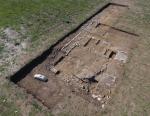Summary (English)
This season, excavation took place in the central sector of the town, at a crossroads identified in an aerial photograph. New data was collected regarding Building B, already partially investigated in 2017, and the northerly continuation of the eastern kerb of the N-S via glareata was uncovered (for about 5 m).
The trench was extended towards the north and it was seen that the building extended N-S for at least 20 m, as the west perimeter wall US 185 was identified to a length of 19.40 m and continued beyond the northern trench edge.
The northern sector of the building presented one large room, of which patches of a cobblestone floor (US 286) and one patch of an opus signinum floor (US 324) were preserved. A small E-W trench was opened perpendicular to US 185, which revealed a series of cobblestone dumps (US 291, 300, 302, 307, 308, 311) that could be a floor make-up. In correspondence with the only opening situated on the north side of Room 1 there was a rectangular pit (US -317) on the same alignment as the building. A lead pipe was found in the layer of humus that could be associated with the pit.
Further excavation between Room 2 and the imperial structures to the east showed that the east wall (US 272) of the building was present in correspondence with the E-W wall US 202, and seemed to be contemporary with it (the structures are only preserved at foundation level or first course). Therefore, it cannot be excluded that the northern part of the building was divided at the time of its construction. A level of cobblestones (US 323) was identified, very probably of natural origin, on which wall 272 stands.
Excavation also took place in correspondence with the building’s SW and SE corners, heavily compromised by the later pits (US -221, -223 and -278) along its front. The removal of the layers of fill from pit US -278 (US 258, 283, 294, 296, 314), in the SE corner revealed the southern perimeter wall US 272 built of tufa blocks directly on a compact layer of cobblestones and clayey soil, probably natural. The continuation of the small channel (US 270), built of tile fragments and mortar and lined with opus signinum, present along the southern edge of the opus signinum floor (US 211) was identified. The channel continued towards the east as far as wall 272 and then turned a right angle to continue southwards.
In the building’s SW corner, the cleaning of the bottom of the large pit US -221 revealed several tufa blocks still in situ that were part of the western perimeter wall (US 185).
The pottery finds seem to confirm the suggested dating for the building of between the 1st century B.C. and the imperial period, with occupation continuing between the 5th and 6th centuries.
- Adriana Valchera-Università del Salento, Dipartimento di Beni Culturali, Laboratorio di Topografia Antica e Fotogrammetria (LabTAF)
- Antonio Leopardi- Università del Salento
Director
- Adriana Valchera-Università del Salento, Dipartimento di Beni Culturali, Laboratorio di Topografia Antica e Fotogrammetria (LabTAF)
Team
- Antonio Leopardi-Università del Salento
- Laureati e Laureandi Università del Salento - Dipartimento di Beni Culturali, Corsi di Laurea triennale in Beni Culturali-curriculum Archeologico e magistrale in Archeologia
Research Body
- Università del Salento, Dipartimento di Beni Culturali, Laboratorio di Topografia Antica e Fotogrammetria (LabTAF)
Funding Body
- Università del Salento, Dipartimento di Beni Culturali






![Download [PDF]](/excavation/skins/fasti/images/results/download_sml.png)